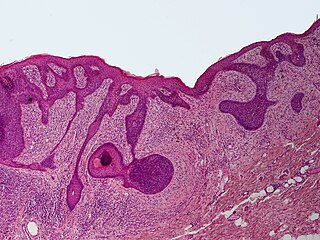| Brooke–Fordyce syndrome | |
|---|---|
| Specialty | Dermatology/oncology |
Brooke–Fordyce syndrome is a condition characterized by multiple trichoepitheliomas.

Trichoepithelioma is a neoplasm of the adnexa of the skin. Its appearance is similar to basal cell carcinoma.
| Brooke–Fordyce syndrome | |
|---|---|
| Specialty | Dermatology/oncology |
Brooke–Fordyce syndrome is a condition characterized by multiple trichoepitheliomas.

Trichoepithelioma is a neoplasm of the adnexa of the skin. Its appearance is similar to basal cell carcinoma.
Rasmussen syndrome is a condition characterized by multiple trichoepitheliomas.
Chondrodysplasia punctata is a clinically and genetically diverse group of rare diseases, first described by Erich Conradi (1882–1968), that share the features of stippled epiphyses and skeletal changes.

Kindler syndrome is a rare congenital disease of the skin caused by a mutation in the KIND1 gene.
Loose anagen syndrome is primarily described in fair-haired children who have easily dislodgable hair.
Ichthyosis linearis circumflexa is a distinctive skin condition of generalized hyperkeratosis and polycyclic and serpiginous erythematous plaques with a characteristic, migratory, double-edged scale at the margins, and is the typical cutaneous manifestation of Netherton's syndrome.
Fibrofolliculomas are 2 to 4 mm in diameter, dome-shaped, yellowish or skin-colored papules usually located on the head, neck, and upper trunk. They are characteristically seen in Birt–Hogg–Dubé syndrome.
Schöpf–Schulz–Passarge syndrome is an autosomal recessive condition with punctate symmetric palmoplantar keratoderma, with the keratoderma and fragility of the nails beginning around age 12. In addition to palmoplantar keratoderma, other symptoms include hypodontia, hypotrichosis, nail dystrophies, and eyelid cysts. Patients may also develop syringofibroadenoma and squamous cell carcinomas.
Tooth and nail syndrome is a rare disorder, first described in 1965, characterized by nails that are thin, small, and friable, and which may show koilonychia at birth.
Pigmented hairy epidermal nevus syndrome is a cutaneous condition characterized by a Becker nevus, ipsilateral hypoplasia of the breast, and skeletal defects such as scoliosis.
Paraneoplastic acrokeratosis, Bazex syndrome is a cutaneous condition characterized by psoriasiform changes of hands, feet, ears, and nose, with involvement of the nails and periungual tissues being characteristic and indistinguishable from psoriatic nails. The condition is associated with carcinomas of the upper aerodigestive tract.
Xanthoma disseminatum is a rare cutaneous condition that preferentially affects males in childhood, characterized by the insidious onset of small, yellow-red to brown papules and nodules that are discrete and disseminated.
Graham-Little syndrome is a cutaneous condition characterized by lichen planus-like skin lesions.

A sebaceous adenoma, a type of adenoma, a cutaneous condition characterized by a slow-growing tumor usually presenting as a pink, flesh-coloured, or yellow papule or nodule.

Trichilemmoma is a benign cutaneous neoplasm that shows differentiation toward cells of the outer root sheath. The lesion is often seen in the face and neck region. Multifocal occurrence is associated with Cowden syndrome, in which hamartomatous intestinal polyposis is seen in conjunction with multiple tricholemmoma lesions.
A trichodiscoma is a cutaneous condition, a benign tumor usually skin colored, most often affecting the face and upper trunk.

Perifollicular fibroma is a cutaneous condition, a benign tumor usually skin colored, most often affecting the face and upper trunk.

The International Standard Book Number (ISBN) is a numeric commercial book identifier which is intended to be unique. Publishers purchase ISBNs from an affiliate of the International ISBN Agency.